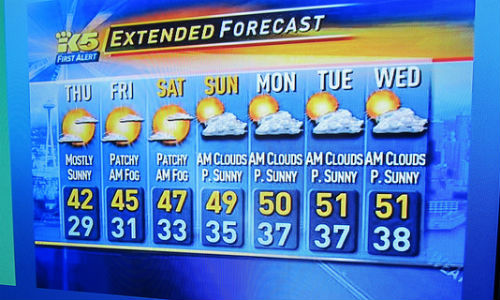Product marketing has a new gold standard: advertisements targeted not just to specific customers, but to the experiences they are having in real time. Companies are increasingly utilizing weather forecasts, which have improved exponentially in accuracy and affordability, to predict what customers will want, and when. Giants in the private weather industry, such as the Weather Company, Weather Underground and Planalytics, are able to predict specific patterns that link purchasing with changes in temperature and precipitation. They are now selling this data to companies, which in some cases have been extremely successful in increasing sales.
6 Facts about Business Meteorology to Jump-Start Your Research
• Weather has a huge impact on business. Its influence on consumer behavior is second only to the state of the economy. An estimated 3 trillion dollars in business in just the private sector is determined by weather.
• Effects from weather vary vastly in different locations. A 70-degree day in some locations triggers sales of sweatshirts, while in others it causes sales to rise in air-conditioning units or warm-weather gear.
• Ever wonder why many malls are kept slightly above average room temperature? Studies have shown that warm temperatures cause customers to feel “closer” to products and value them higher. So can exposure to sun, which increases willingness to spend money by 56 percent. Comfortably warm outside temperatures can boost both in-person and online sale of even non-weather related products.
• As little as a one degree change in weather can affect sales. The “profit of one degree” chart by weathertrends360.com details a wide range of products that experience weather-driven demand. Some examples: When weather increases by one degree, infant apparel sales rise by 4 percent and hedge trimmers by 14 percent.
• Weather can impact how ads resonate. Customers moods are influenced by the weather of the day and marketers can take advantage of this information. For example, negative ads perform better than positive ones on gloomy days.
• Weather forecasters have taken advantage of the increased demand. The private weather industry has blossomed to a $3 billion business. Part of the demand is attributed to an increase in unpredictable weather, as customers strive to tailor ads and ordering to changing conditions.
Reporter’s takeaway
• Find businesses in your area that are using weather forecasting to increase sales. See if they have had success and what weather related trends they see in the area.
• Look for connections between weather patterns and advertising in your area. Talk to consumers to see if they have noticed advertising linked to the weather. What is their opinion on this new sales tactic?
• Ask your local mall if environmental or climate-related factors influence sales.










